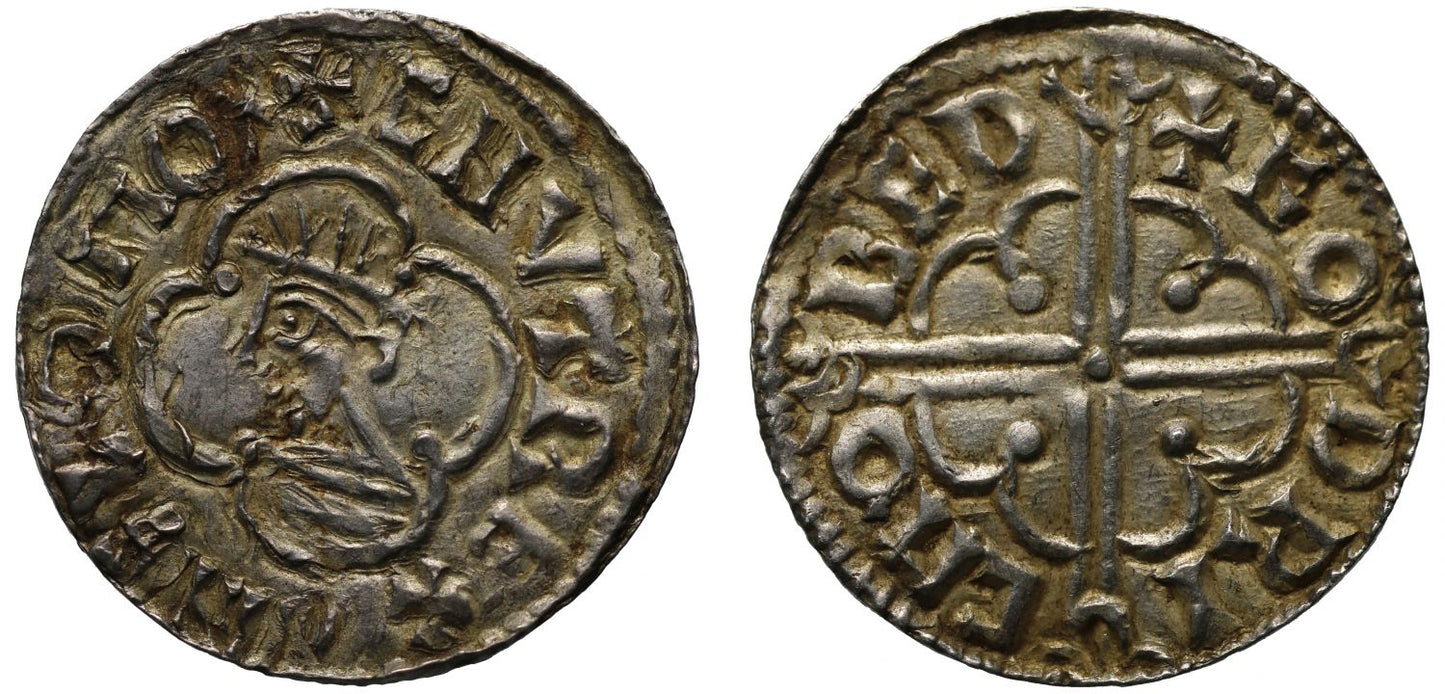FAQs
What makes a coin valuable?
I have coins to sell, what’s the next step?
How will my purchases be shipped?
What happens if I’m not entirely happy with my purchase?
Canute Penny, Quatrefoil type, Bedford Mint, moneyer Godric
Canute (1016-35), silver quatrefoil Penny (c.1017-25), Bedford Mint, Moneyer Godric, crowned and draped bust left within quatrefoil, legend surrounding commences at top, +CNVT REX ANGLOROX, rev. pellet at centre of voided long cross, over quatrefoil with pellet cusps, legend surrounding, +GO DRI C M.O BED, weight 1.17g (SCBI Copenhagen 13:58; BMC type VIII cf.14; N.781; S.1157). Toned with traces of old deposit in legends, well centred, a bold very fine and rare.
The legends translate as "Canute King of the English" on obverse and on the reverse "Godric of Bedford." This Quatrefoil type coin is struck of the Norwich type style as defined by Mark Blackburn and Stewart Lyon in their article "Regional Die-Production in Cnut's Quatrefoil Issue" These dies were therefore cut at Norwich and sent to Bedford. Despite Canute being essentially a Viking King from overseas, the coinages of England continued in a similar vein to those of Aethelred II, in that the types changed every six years, meaning there are three main types for this reign, of which the quatrefoil type was the first. According to North there were up to 74 mints in operation with perhaps four other enigmatic places that remain uncertain. North records nine different moneyers working at Bedford in his reign through three types.
Canute could have been as young as 21 when he ascended the English throne after the 28th November 1016 upon the death of Edmund "Ironside" at Oxford. Though Edmund son of Aethelred II had a younger brother and two infant sons his advisers recognized Canute as successor. Though his birth date is not known, Canute was a commander in his Father's army from 1012, and at first had to settle a number of uprisings amongst the nobility and others, which he quelled by maintaining a large army and navy from heavy taxation. He kept Wessex at first for himself whilst dividing up other areas for regional government under trusted Danish allies. Canute had married Aelfgifu daughter of Ealdorman Aelfhelm of Northumbria, but set her aside to marry Aethelred's widow Emma in 1017 who had fled to Normandy, and this latter union helped maintain the political continuity and tradition of English Kingship. Harald of Denmark died childless in 1018 and Canute used his English troops and finance to extend power to Scandanvia making his infant son Harthacanute titular Governor and heir of Denmark. Canute attempted to invade Sweden, and actually took Norway in 1028 having had a pilgrimage to Rome the year before. Canute left his eldest son by Aelfgifu, Swein to rule Norway and was now the most powerful King of England ever at this time and is likely when the apocryphal story of him trying to vainly order the coastal tide to turn and retreat in front of his courtiers emerged. However, Norway was lost by 1034, Canute did not respond, and he passed away suddenly at Shaftesbury in his mid-forties on the 12th November 1035. Minting activity occurs here from the time of Eadwig until Henry II
Situated nearly 50 miles north-west of London in the Ouse valley, Edward the Elder secured the submission of Thurketil at Bedford in 914, the commanding Earl of the Viking Army based here and subsequently occupied the town in 915. It was later raided by the Danes in 1010 and the castle here was besieged by King Stephen in 1136.
Provenance:
Purchased from A. H. Baldwin January 2020, ex vault stock.
Ex Collection of an English Doctor part II, Sovereign Rarities fixed price list online May 2022.
FAQs
What makes a coin valuable?
I have coins to sell, what’s the next step?
How will my purchases be shipped?
What happens if I’m not entirely happy with my purchase?













